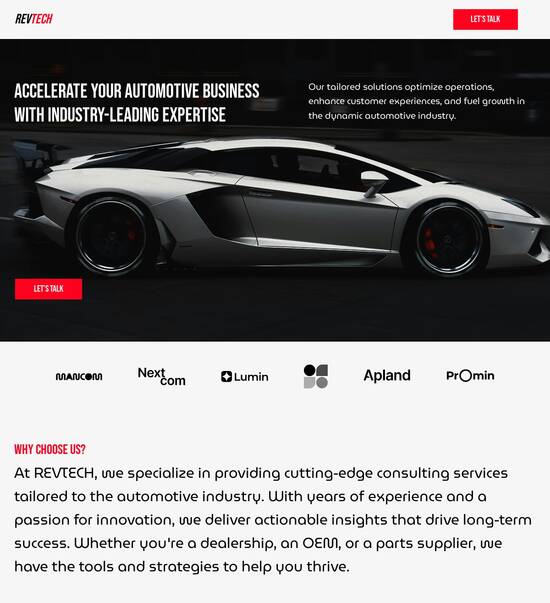
HTML/CSS optimized onboarding page templates
Explore Similar TemplatesAbout template
Make the most with HTML/CSS optimized onboarding page templates. Drive your success today.
Recommended templates

Easy to build without coding
With the intuitive drag-and-drop builder, anyone on your team can create high-converting pages without any knowledge of code or design. Make enhancements to your landing page with custom widgets using Javascript, HTML/CSS, or third-party scripts.

Multiple layouts for any industry and goal
Select from 500+ landing page layouts built to boost conversions across industry-specific scenarios. Customize them by adjusting fonts, adding images, and generating on-brand content with the AI assistant. Quickly scale with Instablocks® and Global Blocks that you can save, reuse, and update globally.

Loads fast and looks polished on any device
Every template is responsive, which means they present professionally on any device and load blazingly fast with our Thor Render Engine. You can also power them up with Google AMP technology to deliver an unparalleled mobile experience and drive higher conversions.

Robust analytics & experimentation
Get real-time updates and reporting across all your devices, showing the number of visitors, conversions, cost-per-visitor, and cost-per-lead. Launch AI-powered experiments, run A/B tests, and use heatmaps to analyze user behavior, then optimize your landing page to maximize conversions.







Easy to build without coding
With the intuitive drag-and-drop builder, anyone on your team can create high-converting pages without any knowledge of code or design. Make enhancements to your landing page with custom widgets using Javascript, HTML/CSS, or third-party scripts.
Multiple layouts for any industry and goal
Select from 500+ landing page layouts built to boost conversions across industry-specific scenarios. Customize them by adjusting fonts, adding images, and generating on-brand content with the AI assistant. Quickly scale with Instablocks® and Global Blocks that you can save, reuse, and update globally.
Loads fast and looks polished on any device
Every template is responsive, which means they present professionally on any device and load blazingly fast with our Thor Render Engine.
Robust analytics & experimentation
Get real-time updates and reporting across all your devices, showing the number of visitors, conversions, cost-per-visitor, and cost-per-lead. Launch AI-powered experiments, run A/B tests, and use heatmaps to analyze user behavior, then optimize your landing page to maximize conversions.
All the features you need to build tailwind user onboarding page
Explore more featuresLearn how to build tailwind css user onboarding page
Frequently asked questions about tailwind user onboarding
Leading the way in building high-performing landing pages





Tailwind css user onboarding form: Your ultimate how-to guide
Instapage offers an extensive suite of tools tailored for marketers to enhance their digital campaigns. This guide will walk you through utilizing Instapage effectively to supercharge your landing page strategies and maximize your return on investment (ROI). Whether you're optimizing existing funnels or building new ones, getting started with Instapage ensures your campaigns are not only eye-catching but also conversion-focused.
Getting started with Instapage
To make the most of Instapage, you'll appreciate the intuitive interface and extensive customization options available. Start by selecting a blueprint that resonates with your campaign's objectives. With over a hundred pre-designed templates, finding the perfect fit for any industry is a breeze. Be it for education, finance, or tech, these templates ensure a robust starting point.
- Choose from over 100 customizable templates that are optimized for conversions.
- Use the drag-and-drop functionality to add or replace elements effortlessly.
- Integrate lead generation tools like forms and pop-ups to maximize signup rates.
Optimizing campaigns with analytics and A/B testing
After your landing page is live, the real work begins with optimization. Instapage's built-in analytics tools provide deep insights into how visitors interact with your pages. Leverage A/B testing to refine elements and observe which variations drive more conversions.
- Analyze heatmaps to identify where users spend the most time on your page.
- Conduct A/B tests on headlines and call-to-action (CTA) buttons to discover the most effective options.
- Review engagement metrics to understand audience behavior and preferences.
Personalizing user experiences
Personalization is key to driving engagement. Instapage allows for dynamic text replacement, ensuring your messaging resonates with specific audience segments. Tailor content based on user attributes and demographics, resulting in a more compelling experience for each visitor.
- Implement dynamic text replacement to align page content with the keywords/search terms users used.
- Create unique landing pages for individual campaigns using Instablocks.
- Track audience-level metrics to measure engagement and conversion rates across demographics.
In summary, leveraging these features not only enhances your marketing effectiveness but sets your campaigns up for success. Instapage revolutionizes how marketers engage with their audience through seamless enhancements and data-driven decisions.
If you're ready to elevate your landing pages and streamline your marketing efforts, exploring the full capabilities of Instapage is your next logical step.
HTML/CSS optimized onboarding page template
Understanding the necessity of an optimized onboarding page
An optimized onboarding page is crucial for businesses aiming to enhance user retention. The initial user experience can make or break the relationship they form with your website. Ensuring that users are engaged right from day one is essential for long-term success.
A well-designed onboarding process can dramatically improve user retention rates. According to research, users who have positive onboarding experiences are 50% more likely to engage and stay active over time. Simply put, the first impression matter.
Simplicity and clarity in design ensure that users can quickly understand how to use the platform.
Balancing the amount of information presented with user engagement techniques keeps users interested without overwhelming them.
Core features of an HTML/CSS optimized onboarding page template
Implementing dynamic content through tools like the Canvas API can enhance user experience significantly. This API allows for the creation of visually engaging and interactive experiences that adapt to user interactions, promoting a more engaging onboarding journey.
Moreover, employing semantic HTML can support SEO efforts, ensuring that the onboarding page does not just engage visitors but also ranks well in search engine results. This allows the page to attract more users organically.
The Canvas API allows dynamic updates to the onboarding experience without the need for page reloads.
Semantic HTML structures content in a way that is understandable for both users and search engines.
The importance of performance in user experience
Performance is a critical factor in user experience. One straightforward way to improve the speed of a website is through CSS minification. Minifying CSS reduces the file size by eliminating unnecessary whitespace and comments, leading to faster load times. This simple step can significantly enhance user engagement by providing a smoother experience.
Image optimization is another crucial aspect. By compressing images and selecting appropriate formats, you can drastically reduce loading times. Utilizing tools like TinyPNG or ImageOptim can help streamline this process.
Use tools such as CSSNano or UglifyCSS for effective CSS minification.
Implement image formats that balance quality and file size, such as WebP.
Additionally, integrating technologies like WebAssembly can create rich user interfaces by leveraging native performance advantages over traditional JavaScript, thus improving overall experience.
Structuring your template for optimal website performance
Adopting the HTTP/2 protocol can drastically improve resource loading efficiency. HTTP/2 allows multiple requests to be sent over a single connection, which significantly speeds up loading times compared to HTTP/1.1 where each request had to establish its own connection.
It's also essential to organize files and fonts effectively. Keeping assets structured within directories not only makes the maintenance easier but also improves loading speeds. Utilizing the font-display property can control how fonts load, further optimizing user experience.
Enable HTTP/2 on your server for better multiplexing of requests.
Structure your file directories to improve asset retrieval times.
Implementing code splitting and lazy loading can further enhance performance. By delivering only the necessary code to users initially and loading other resources as needed, you ensure a faster perceived load time.
Designing for engagement: Integrating animations and interactivity
Integrating subtle CSS animations into your onboarding page can significantly improve user engagement. These animations can guide users towards important features, making the experience more intuitive and enjoyable. Consider using animations to highlight CTA buttons or illustrate steps in the onboarding process.
Responsiveness is equally vital, as it ensures elements adapt smoothly to various devices and screen sizes. This adaptability is key to keeping users engaged, particularly when accessing the site through mobile devices.
Use CSS transitions and animations sparingly to maintain a professional feel.
Ensure all interactive elements are responsive and accessible on all device types.
Tools and technologies for implementing your onboarding template
When crafting your onboarding page, leveraging frameworks like Bootstrap or Tailwind CSS can provide pre-designed components that enhance development speed. These frameworks offer a variety of design options that can help maintain consistency and save time during the development process. It's essential to select a framework that aligns with your project needs.
Additionally, utilizing version control systems such as Git can streamline collaborative efforts. Maintaining code quality and facilitating effective communication among team members is critical, especially in larger teams where multiple features may be in development simultaneously.
Bootstrap is ideal for quick prototyping with its extensive components library.
Tailwind CSS offers utility-first design which allows for deep customization.
Measuring success: Key metrics to track performance and engagement
To understand the effectiveness of your onboarding page, it's vital to identify key performance metrics. Indicators such as load time and bounce rate provide insights into how efficiently the page operates. Tools like Google Analytics can help track these metrics effectively, giving you data to make informed improvements.
User engagement metrics are equally important. Metrics such as completion rates and interaction depth offer a clear view of how users are interacting with the onboarding process. Analyzing these metrics can drive changes aimed at improving user experience.
Monitor load times to ensure optimal performance.
Evaluate user engagement through interaction metrics.
Case studies: Real-world examples of optimized onboarding experiences
Analyzing successful onboarding pages can provide valuable insights. For example, many tech companies have streamlined their onboarding processes by focusing on user-centric design and engaging content. By examining these real-world examples, you can glean strategies that are proven to work.
Lessons learned from these case studies can guide your own optimization efforts. Implementing similar structures or features may result in enhanced user engagement and retention on your onboarding page.
Future trends in onboarding page optimization
As technology evolves, staying informed about emerging tools and frameworks is essential for optimizing onboarding pages. AI integration, for instance, offers new avenues for personalization that can greatly enhance user experience by tailoring content based on user behavior and preferences.
Personalization will continue to play a crucial role in onboarding design. Tailoring experiences not only boosts engagement but also increases the likelihood of users returning. Implementing personalization features without compromising performance will be key to future successes.
Watch for advancements in AI that could improve user targeting.
Focus on personalizing content based on user preferences and actions.
Ready to skyrocket conversions?
Supercharge your ad campaigns with high-performing landing pages
Get started














